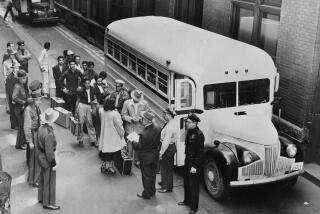Bit of S.D. History, Carved in Stone, May Be Saved
- Share via
It was viewed as a prized victory for local preservationists and historians, but to 77-year-old Marie Buck it was simply putting things “back where they belong.”
Buck remembers vividly that November day in 1917 when her 6-year-old brother, Charlie Teurlay, who died of the Spanish flu, was buried in what was then Calvary Cemetery in Mission Hills. Her father, a French immigrant who spoke little English, commissioned a stone carver to fashion a tombstone with the inscription “Missed So Much For Their Parents.” That was precisely what the carver engraved on the stone.
“It was an obvious mistake,” Buck said. “I don’t know why it wasn’t changed.”
Nonetheless, the tombstone with the grammatical error, which marked the grave of little Charlie Teurlay, represented a historical slice of Buck’s family and the new life they staked out in San Diego in 1917.
In 1970, because of deteriorating conditions in the cemetery off Washington Street, about 300 of the grave markers, including Charlie Teurlay’s, were removed by the city and dumped in a ravine in the Mount Hope Cemetery in Southeast San Diego so that Calvary Cemetery could be transformed into a park. Only 147 markers deemed of historical significance to San Diego were left in a corner of what is now called Calvary Pioneer Memorial Park, which consists of green, open space.
“At the time we didn’t raise a fuss because the cemetery was in such disrepair and vandalized, and there was some talk of putting the markers in Mount Hope,” said Buck, who lives in Normal Heights.
Once, Buck visited the ravine where the markers were dumped.
“It was heartbreaking to see them scattered every which way like that,” she said. “It just didn’t seem right. They belonged back in the park.”
Thanks to the efforts of local historians and preservationists, that may happen. A City Council committee voted unanimously last week to return the discarded markers to the Mission Hills park. When the park was created, the tombstones were moved but the graves remained. The last burial there was in 1960.
That committee’s decision--which still needs approval from the full council--was made despite a city manager’s report recommending that the tombstones thrown in the ravine be buried to make them invisible to passengers aboard the San Diego Trolley.
“When the notice came out about the city manager’s recommendations, a number of organizations thought that was not a respectful or appropriate way to dispose of gravestones,” said Kathryn Willetts, chairwoman of the historical site board. “The moral and culturally appropriate thing would be for the city to retain the stones.”
Corey Braun, an archivist at the San Diego Historical Society who showed slides of the tombstones to the council committee, says the grave markers are more than historically important.
“Besides the historical perspective, the tombstones are works of art that should be preserved,” said Braun, who has several cousins and uncles who were buried in Calvary Cemetery and whose grave markers are probably in the ravine.
Although nearly 70 years have passed since Buck’s brother was buried, Buck remembers the exact location of his grave.
“I know exactly where my brother’s little bones are buried,” she said. “It’s 43 steps from the south wall . . . “
More to Read
Sign up for Essential California
The most important California stories and recommendations in your inbox every morning.
You may occasionally receive promotional content from the Los Angeles Times.










